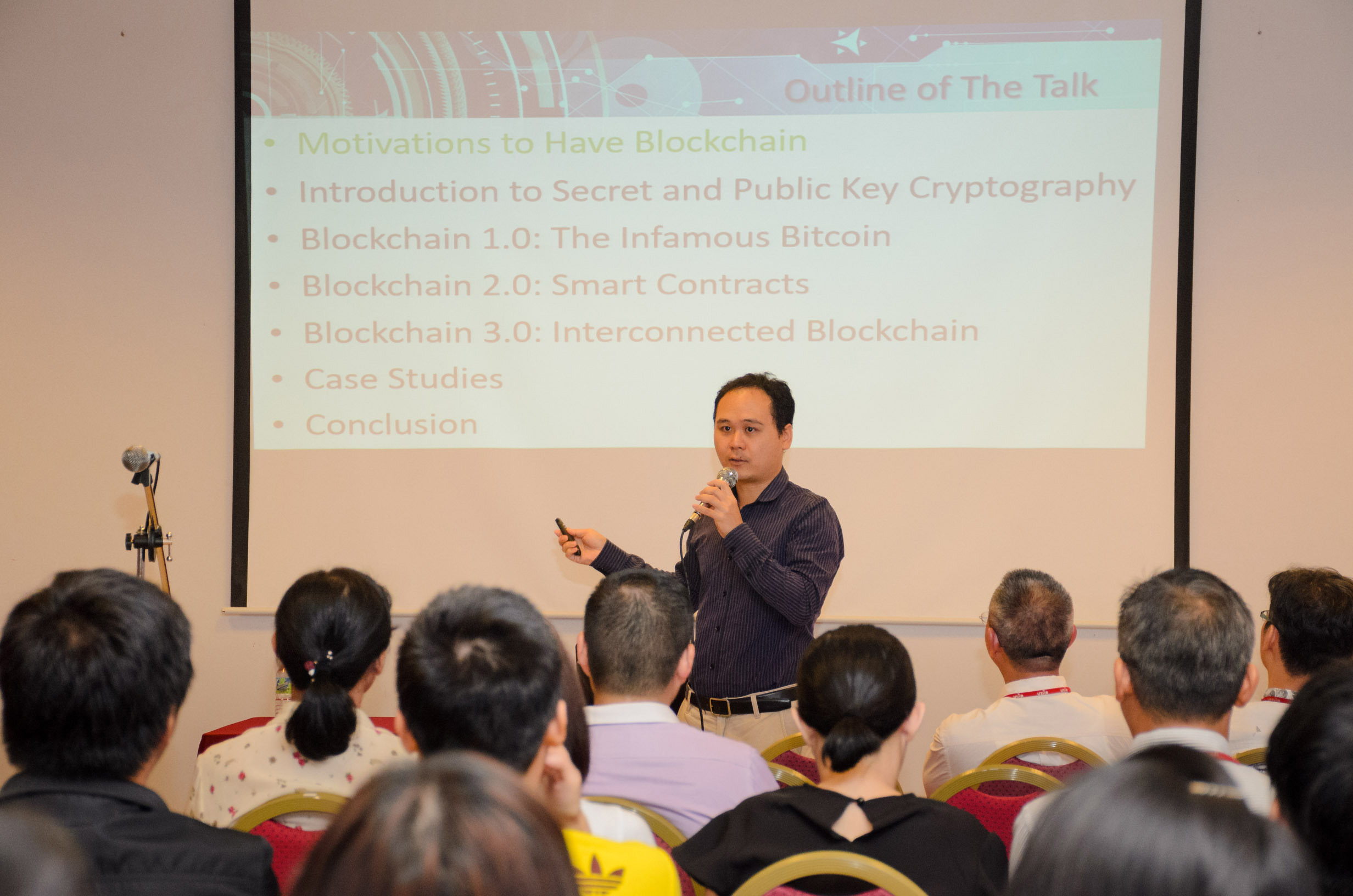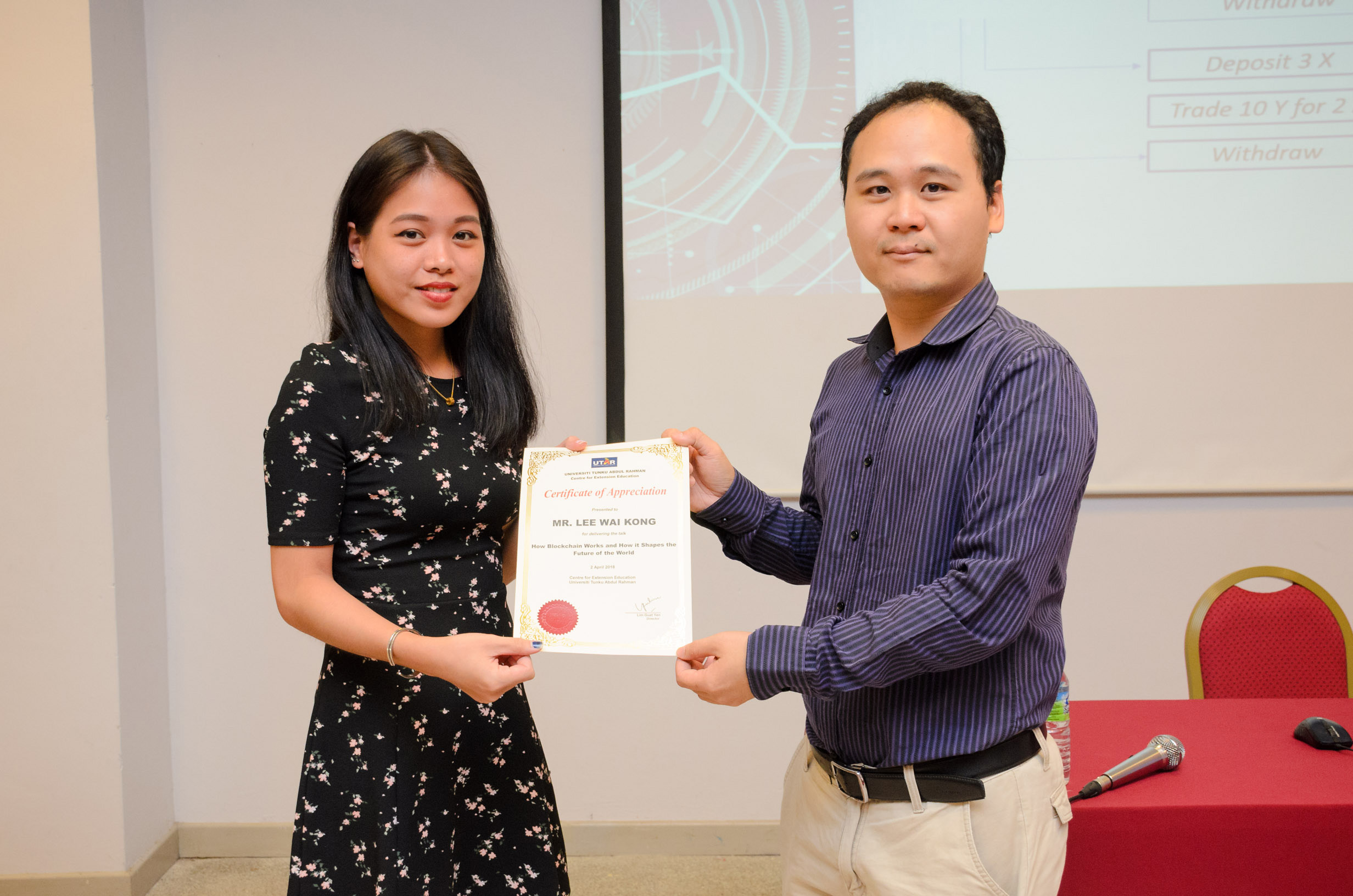
UTAR’s Centre for Extension Education successfully organised a talk titled “How blockchain works and how it shapes the future world” at its Kampar Campus on 2 April 2018. The invited speaker for the talk was UTAR Faculty of Information and Communication Technology (FICT) lecturer Lee Wai Kong.

Lee introducing the meaning of Blockchain
The talk aimed to introduce the basics of Blockchain 1.0: The Infamous Bitcoin and Blockchain 2.0: Smart Contracts; and its operating principles as well as its historical development. The talk also focused on aspects such as the motivations to have Blockchain, the secret and public key cryptography and some case studies of Blockchain in current and future society. It was attended by more than 150 participants comprising UTAR staff and students.
At the talk, the participants were enlightened with the definition of Blockchain 1.0 and Blockchain 2.0, which included the history and difference between the two technologies.
Lee explained, “Blockchain is a public electronic ledger which is dissimilar to a relational database that can be openly shared among different users and that creates an unchangeable record of their transactions, each one time-stamped and linked to the previous one. Blockchain contains a verifiable record of every single “transaction” made. The adding of the blocks in chains forms a timeline. The transaction cannot be modified once it has been recorded, because any change in any single block would require the alteration of all subsequent blocks. Another reason for this near-impossible modification is also due to Blockchain’s nature – the information is distributed across a decentralised, worldwide network of computers. Instead of using a central entity to manage the chain, Blockchain engages in a peer-to-peer network in which different parties are allowed to join. The party joining the network gets the full copy of the Blockchain. This will significantly deter any forgery of the certificates because the forged documents are not discovered in the blocks at the first place.”
Lee elucidated that the process of understanding Blockchain begins with understanding Bitcoin, as Blockchain was born out of the vision for Bitcoin. He added, “Bitcoin software was launched in 2009 to create a digital currency that could be transferred directly between two or more parties without the need of a central authority mechanism that could step validate transactions, avoid fraud and eliminate the risk of double-spend. Meanwhile, Blockchain was designed to facilitate a wide variety of transactions even those outside of crypto-currencies such as escrow transactions, bonded contracts, third-party arbitration and multiparty signatures. In short, Blockchain 1.0 was for the decentralisation of money and a payment, Blockchain 2.0 is for the decentralisation of markets more generally.”
He further emphasised, “As much as Blockchain is increasingly popular, it is mostly being explained from the financial point of view and most people happen to know it via exposure to cryptocurrency. But in actual fact, this technology’s function extends beyond cryptocurrency trading. Today, the Blockchain technology has managed to pique other people’s interests as it is being tested to store medical records, collecting taxes and many more. In UTAR’s case, Blockchain is used to not only certify the digital degree certificates but also allows the employers to verify their authenticity.”
Blockchain is an emerging technology based on distributed computing system and cryptography. Bitcoin is one of the most widely known applications of Blockchain technology which revolutionised the development of crypto-cash. Later on, Blockchain 2.0 was conceptualised and attracted a lot of attention from various industries including finance (FinTech), manufacturing, auditing and renewable energy (SolarCoin).”
Lee is a lecturer at UTAR FICT. He obtained his Bachelor of Engineering (Hons) Electronics in 2006 and Master of Engineering Science in 2009 from Multimedia University. Prior to joining UTAR, he worked as a firmware engineer at several multinational companies including Agilent Technologies and Xyratex Sdn. Bhd. His current research interests include Cryptography, GPU computing energy harvesting and Internet of Things (IoT).
The talk ended with an interactive Q&A session and a souvenir presentation by CEE Kampar Assistant Manager Lim Wei Qi to Lee.

Participants listening attentively to Lee

Lim (right) presenting a souvenir to Lee
© 2019 UNIVERSITI TUNKU ABDUL RAHMAN DU012(A).
Wholly owned by UTAR Education Foundation Co. No. 578227-M LEGAL STATEMENT TERM OF USAGE PRIVACY NOTICE